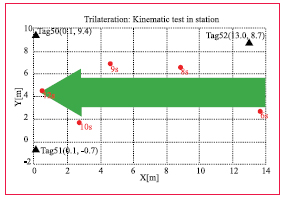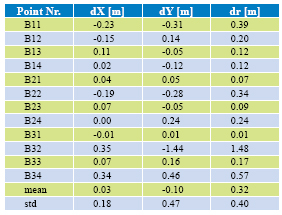| LBS, Positioning | |
Active RFID trilateration for indoor positioning
| Guenther Retscher and Qing Fu | |||||||||||||||||||||
| Conclusion and outlook
This paper addresses the investigation of RFID trilateration for indoor positioning. At first some background of RFID was introduced. On this basis it was deduced how the measured signal strength can be converted into a distance. The converted distances could be used for determining the position of the reader by means of trilateration. Finally, the approach was tested in a test environment near the Vienna University of Technology. Acknowledgements References * Fu Q., 2008. Active RFID for Positioning Using Trilateration and Location Fingerprinting Based on RSSI. in: Papers presented at the ION GNSS 2008 Conference, September 16-19, 2008, Savannah, Georgia, USA, CD-Rom Proceedings. * Ranvier S., 2004. Path Loss Models, S-72.333 Physical Layer Methods in Wireless Communication Systems, Postgraduate Course on Radiocommuications, Helsinki University of Technology, SMRAD Centre of Excellence, http://www. comlab.hut.fi/opetus/333/ 2004_2005_ slides/Path_loss_models.pdf (Last date accessed: April 2008). * Retscher G., Q. Fu, 2007a. Integration of RFID, GNSS and DR for Ubiquitous Positioning in Pedestrian Navigation. in: Papers presented at the ION GNSS 2007 Conference, September 25-28, 2007, Fort Worth, Texas, USA, CD-Rom Proceedings. * Retscher G., Q. Fu, 2007b. Using Active RFID for Positioning in Navigation Systems, in: Papers presented at the 4th Symposium on Location Based Services and Telecartography, November 8-10, 2007, Hong Kong, PR China. * Retscher G., Q. Fu, 2008. RFID Trilateration for Indoor and Outdoor Positioning, in: Papers presented at the European Navigation Conference ENC-GNSS 2008, April 22-25, 2008, Toulouse, France. * Wikipedia, 2008. ITU Model for Indoor Attenuation, see http:// en.wikipedia.org/wiki/ITU_Model_ for_Indoor_ Attenuation (Last date accessed: April 2008). |
|||||||||||||||||||||
|
|||||||||||||||||||||
|


















 (13 votes, average: 1.92 out of 5)
(13 votes, average: 1.92 out of 5)



Leave your response!